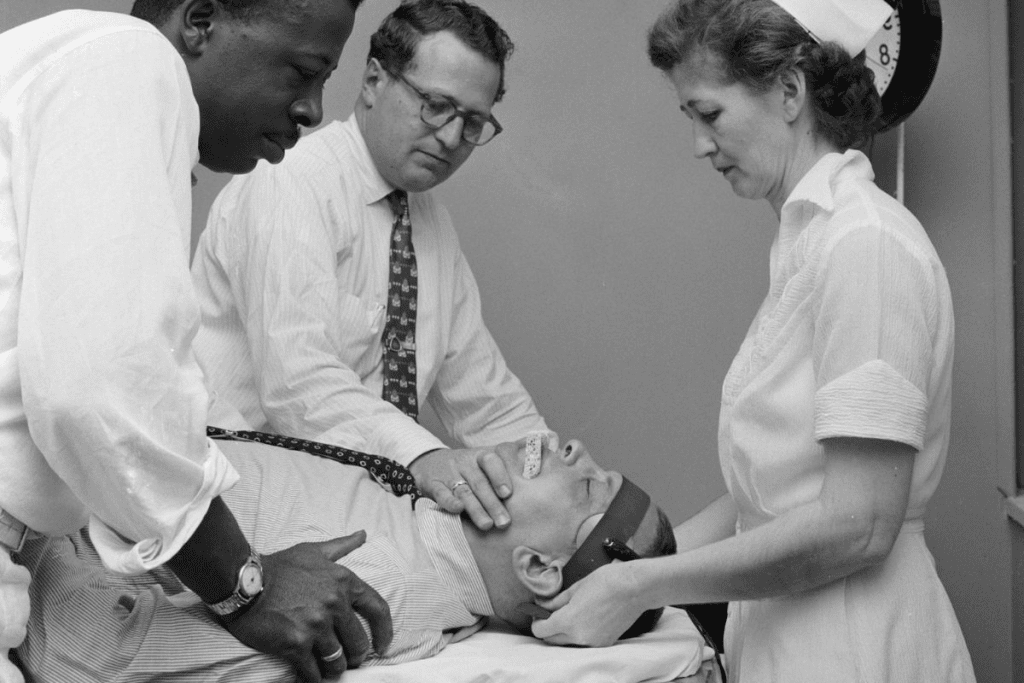Last Updated on November 25, 2025 by
For centuries, historical kidney stone treatments has been a painful problem for humans. Ancient civilizations struggled to find effective treatments. We look at how our ancestors dealt with this issue, often using risky and invasive methods.

Early historical kidney stone treatment methods were harsh and often deadly. Ancient India is known for some of the earliest surgeries for this condition. Today, we have much better ways to treat kidney stones, improving care for patients everywhere.
Ancient civilizations knew a lot about kidney stones. They used different ways to find and treat this painful problem. In ancient Egypt, Greece, and Rome, doctors like Hippocrates talked about how to treat it.

In these old times, doctors wrote about herbal remedies and diet changes for historical kidney stone treatment. For example, the Ebers Papyrus, an ancient Egyptian medical text, lists treatments for urinary problems, possibly including kidney stones. Greek and Roman doctors used herbal mixtures and diet plans to help with kidney stone pain.
Using traditional remedies historical kidney stones treatments was common. It showed a mix of observation, knowledge, and sometimes, myths. These old medical practices helped start the journey of history of urology stone removal.
Back then, doctors looked for symptoms like severe pain and trouble urinating to diagnose historical kidney stone treatment. Patients suffered a lot, as treatments were often as painful as the condition itself. The historical kidney stone treatments disease shows the big challenges for patients and doctors.
Even with limited knowledge, ancient doctors knew kidney stones were a big health problem. The journey from ancient treatments to today shows a constant effort to help patients with kidney stones.
Before modern medicine, people used herbal remedies and changed their diets to treat historical kidney stone treatment. Our ancestors turned to nature to ease the pain of these stones.
Many medicinal plants were used to treat kidney stones. Herbal concoctions from plants like Urtica dioica (stinging nettle) and Taraxacum officinale (dandelion) were common. These plants were thought to help by increasing urine production.
16th-century herbalist noted,”the root of the dandelion, boiled in wine, doth wonderfully help them that are troubled with the historical kidney stone treatments.”
These remedies were passed down, mixing observation with a bit of superstition.
Diet was key in managing kidney stones. Patients were told to eat certain foods to prevent new stones or ease symptoms. A historical kidney stone treatments diet full of fruits and veggies was suggested, as they were believed to help dissolve stones.
Fluid therapies, like drinking mineral waters, were also used. Mineral waters were thought to have healing powers that could dissolve or flush out stones.

Patients went to spas or mineral water baths. They drank and bathed in the water, hoping it would help their condition.
The historical kidney stone treatment is filled with painful and dangerous surgeries. Early methods were risky and often led to many deaths. We will look at how these methods were developed and the challenges they faced.
Perineal lithotomy, or “cutting for stone,” was used for centuries. It involved cutting in the perineum to reach the bladder and remove stones. This method was very risky, with high chances of infection, bleeding, and damage to tissues. It was a main way to remove stones until better methods came along.
Suprapubic approaches made an incision above the pubic bone to get to the bladder. This method was hard because of the anatomy, needing to avoid important structures. It was a complex procedure that required a lot of skill and was risky. These challenges show how tough it was for early surgeons.
Old records show that these surgeries had high death rates and many complications. Some of these complications were:
These issues highlight the harsh realities of early stone removal surgeries. They show why we need to keep improving medical treatments.
Knowing about these old methods helps us appreciate how far we’ve come in historical kidney stone treatment. We’ve made big strides in making these treatments safer. Ongoing research aims to keep improving results for patients.
The 19th century was a game-changer for treating kidney stones. New technologies and medical discoveries greatly improved how we manage these painful stones. These advancements paved the way for today’s treatments.
In 1824, Jean Civiale created the lithotripter. This device could break historical kidney stone treatment inside the body, avoiding the need for surgery. The invention of lithotripsy was a big step towards less invasive treatments. It made treatments safer and reduced recovery times.
Anesthesia arrived in the 19th century, changing stone surgery forever. It made procedures much less painful for patients. Anesthesia allowed for more complex surgeries, making them easier to perform.
Antiseptic techniques were introduced in the 19th century. They greatly reduced death rates from historical kidney stone treatment surgeries. By cutting down infection risks, these techniques made surgeries safer and more effective.
In summary, the 19th century was a turning point for kidney stone treatment. Innovations like lithotripsy, anesthesia, and antiseptics greatly improved outcomes. These breakthroughs are the basis of today’s treatments, shaping modern medicine.
Throughout history, cultures have found unique ways to treat kidney stones. These methods show the creativity and resourcefulness of ancient societies. They highlight the diversity in addressing this painful condition.
In Europe, people used local plants and animals tohistorical kidney stone treatment. For example, herbal concoctions from plants like Urtica dioica (stinging nettle) were popular. Superstitions also played a role, with some believing rituals or charms could help pass stones.
In the Middle East and Asia, Unani and Ayurveda have treated kidney stones for centuries. These systems use natural products and dietary changes. For instance, herbs and minerals are believed to help dissolve or pass stones.
Native American and indigenous cultures have their own ways to historical kidney stone treatment. These methods often use local plants and spiritual practices. They include the use of sacred plants and ritual ceremonies for healing and purification to historical kidney stone treatments
The variety of traditional stone treatments across cultures shows humanity’s diverse efforts to tackle kidney stones. While these methods may not match modern medicine, they are vital to understanding our cultural heritage and history of treating kidney stones.
We’ve looked at how kidney stone treatments have changed over time. From ancient times to today, there have been big steps forward. These changes have made historical kidney stone treatment much safer and more effective.
Old treatments were often risky, using everything from herbs to major surgery. But in 1824, Jean Civiale created a device that could break up stones without surgery. This was a big step forward. It led to even better treatments like Extracorporeal Shock Wave Lithotripsy (ESWL).
Now, we have treatments that are much safer and work better. Thanks to new technology, patients recover faster and face fewer problems. Looking back, it’s clear that medical science has greatly improved how we treat historical kidney stone treatment.
This journey shows us how important it is to keep improving healthcare. We need to keep finding new ways to help patients. This way, we can make sure everyone gets the best care possible.
Ancient civilizations like Egypt, Greece, and Rome used many ways to treat kidney stones. They used herbal remedies, followed certain diets, and gave fluids. They also tried to diagnose by watching symptoms and doing manual checks.
Traditional remedies included plants, herbal mixes, and mineral waters. Each culture had its own way, like European, Middle Eastern, Asian, Native American, and indigenous methods.
The 19th century saw big changes in historical kidney stone treatment. Jean Civiale invented the lithotripter to break stones inside the body. Anesthesia and antiseptics also made surgery safer, cutting down on deaths.
Early surgeries like perineal lithotomy and suprapubic approaches were very risky. They had high death rates and caused many complications. These methods were very painful and invasive, making patients suffer a lot.
Modern treatments have moved away from dangerous surgeries to safer, non-invasive options. Now, we have treatments like lithotripsy and other minimally invasive methods. These have greatly improved how well patients do.
Yes, some old methods like diet changes and fluid therapy are used today, but in new ways. Also, some herbal remedies from the past are used in different parts of the world.
We learn that treating kidney stones has improved a lot over time. This shows how medical science and technology have advanced. By looking at the past, we can see how far we’ve come and keep improving care for patients.
Subscribe to our e-newsletter to stay informed about the latest innovations in the world of health and exclusive offers!